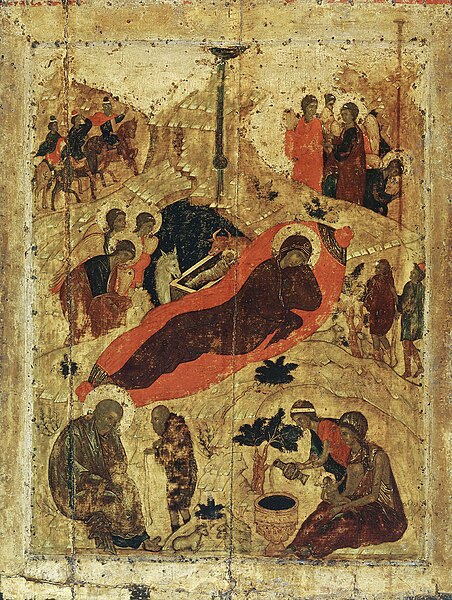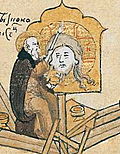Fasciculus:Nativity (15th c., Annunciation Cathedral in Moscow).jpg

Mensura huius perspectionis: 452 × 600 elementa imaginalia. Aliae mensurae: 181 × 240 elementa imaginalia | 362 × 480 elementa imaginalia | 579 × 768 elementa imaginalia | 771 × 1 024 elementa imaginalia | 1 400 × 1 858 elementa imaginalia.
Sua resolutio (1 400 × 1 858 elementa imaginalia, magnitudo fasciculi: 972 chiliocteti, typus MIME: image/jpeg)
Historia fasciculi
Presso die vel tempore fasciculum videbis, sicut tunc temporis apparuit.
| Dies/Tempus | Minutio | Dimensiones | Usor | Sententia | |
|---|---|---|---|---|---|
| recentissima | 11:08, 17 Octobris 2017 |  | 1 400 × 1 858 (972 chiliocteti) | Павло Сарт | Reverted to version as of 13:06, 22 January 2007 (UTC) |
| 15:07, 27 Septembris 2015 |  | 1 000 × 1 304 (265 chiliocteti) | Shakko | ||
| 13:06, 22 Ianuarii 2007 |  | 1 400 × 1 858 (972 chiliocteti) | Alex Bakharev | Рождество Христово. Андрей Рублёв, Nativity Cathedral of the Annunciation of the Moscow Kremlin, 1405 {{Creator:Andrej Rublëv}} From http://lj.rossia.org/users/john_petrov/654558.html Category:Nativity in art |
Nexus ad fasciculum
Ad hunc fasciculum nectunt:
Usus fasciculi per inceptus Vicimediorum
Quae incepta Vici fasciculo utuntur:
- Usus in ar.wikipedia.org
- Usus in ast.wikipedia.org
- Usus in az.wikipedia.org
- Usus in ba.wikipedia.org
- Usus in bcl.wikipedia.org
- Usus in bg.wikipedia.org
- Usus in bxr.wikipedia.org
- Usus in ca.wikipedia.org
- Usus in ceb.wikipedia.org
- Usus in ce.wikipedia.org
- Usus in cs.wikipedia.org
- Usus in el.wikipedia.org
- Usus in en.wikipedia.org
- Andrei Rublev
- Royal Hours
- Nativity of Jesus in art
- User:Maralia/Happystuff
- User talk:Tim riley/Archive5
- User talk:Ruhrfisch/Archive 40
- User talk:Gerda Arendt/2014
- User talk:John/Archive 2014
- User talk:Risker/Archive 15
- User talk:Wehwalt/Archive 17
- User talk:Victoriaearle/Archive 13
- User talk:Curly Turkey/Archive/2014
- User talk:Martinevans123/Archive 8
- User talk:DPL bot/Archive 6
- User talk:Casliber/Archive 47
- User talk:Crisco 1492/Archive 56
- User talk:MONGO/Archive34
- User talk:Bencherlite/Archive 29
- User talk:Brianboulton/Archive 84
- User talk:Hafspajen/Archive 2
- User talk:Kafka Liz/Archive 8
- User talk:Johnbod/30
- User talk:Adam Cuerden/Archive 5
- User talk:Maralia/Archive 15
- User talk:SlimVirgin/December 2014
- User talk:Modernist/Archive9
- User talk:SandyGeorgia/arch103
- User talk:Tom harrison/Archive13
- User:Officiallyaninja/sandbox
- User talk:Lasha-george/sandbox
- Usus in es.wikipedia.org
- Usus in fa.wikipedia.org
- Usus in fi.wikipedia.org
View more global usage of this file.

